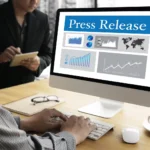In the fast-paced world of digital marketing, press releases remain a vital tool for brands aiming to enhance visibility and engagement. This article delves deeper into the strategies for crafting effective digital press releases and how to leverage them for maximum impact, while also addressing common questions about their use.
Understanding the Press Release Landscape

A press release is a formal announcement that communicates newsworthy information to the media and the public. While traditionally used for significant events like product launches or company milestones, press releases have evolved into essential tools for brand storytelling and audience engagement.
The Role of Press Releases in Marketing
Press releases serve multiple purposes in marketing, including:
- Establishing Credibility: By providing factual information, brands can build trust with their audience.
- Generating Media Interest: A well-crafted press release can attract journalists and media outlets, leading to potential coverage.
- Driving Traffic: When published online, press releases can direct traffic to a brand’s website, increasing visibility and engagement.
Benefits of Digital Press Releases
Digital press releases offer distinct advantages over traditional methods:
- Wider Reach: Digital platforms enable instant global distribution, reaching a broader audience than print media.
- SEO Benefits: Incorporating relevant keywords and backlinks can enhance search engine rankings, driving organic traffic.
- Engagement Opportunities: Multimedia elements like images and videos can make press releases more engaging and shareable.
- Real-Time Analytics: Digital tools allow for tracking performance, providing insights into media mentions and audience engagement.
Crafting an Effective Digital Press Release
Creating a compelling digital press release involves several key elements:
1. Compelling Headline
The headline should be concise and attention-grabbing, summarizing the main point of the announcement. A strong headline increases the chances of media coverage.
2. Engaging Lead Paragraph
The lead should answer the 5 W’s (who, what, when, where, why) to provide essential information and entice readers to continue.
3. Body Content
The body should elaborate on the announcement, including context, quotes from key stakeholders, and relevant data. It should maintain a journalistic tone, avoiding overly promotional language.
4. Multimedia Integration
Incorporating images, videos, or infographics enhances the appeal of a press release, making it more likely to be shared across social media platforms.
5. Clear Call to Action
A well-defined call to action directs readers on what to do next, whether visiting a website or signing up for a newsletter.
Distribution Strategies for Maximum Impact
The effectiveness of a press release is heavily influenced by its distribution strategy. Here are several approaches to consider:
1. Utilize Online Distribution Services
Using platforms like PR Newswire or Business Wire can help distribute press releases to a wide audience of journalists and media outlets.
2. Build Relationships with Journalists
Nurturing relationships with journalists can increase the likelihood of coverage. Personalized pitches that highlight the newsworthiness of a press release can lead to more significant media attention.
3. Leverage Social Media
Sharing press releases on social media platforms can amplify reach and encourage engagement from followers. Using relevant hashtags can also increase visibility among target audiences.
4. Monitor and Analyze Performance
Tracking the performance of press releases is crucial for understanding their impact. Metrics such as media mentions, website traffic, and social media engagement can provide insights for future campaigns.
Challenges and Considerations
Despite their benefits, there are challenges associated with press releases in the digital age:
- Information Overload: With numerous press releases circulating daily, it can be challenging for any single release to stand out.
- Quality Over Quantity: The effectiveness of digital press releases hinges on their quality. Poorly written or irrelevant releases can damage a brand’s reputation.
- Evolving Media Landscape: Brands must adapt their strategies to changing media consumption habits and audience preferences.
Best Practices for Writing and Distributing Press Releases

To ensure your press releases are effective, consider the following best practices:
- Focus on Newsworthiness: Ensure your press release contains newsworthy information that will interest your target audience.
- Optimize for SEO: Use relevant keywords and backlinks to improve search engine visibility.
- Maintain a Standard Format: Follow a recognized press release format to make it easy for journalists to find the information they need.
- Use Data and Quotes: Incorporate statistics and quotes from key stakeholders to add credibility and context.
- Engage with Your Audience: Encourage readers to engage with your content by asking questions or inviting feedback.
Conclusion
Press releases remain a powerful tool for brands looking to enhance visibility and engage with their audiences. By leveraging digital channels and employing effective strategies, brands can maximize the impact of their press releases, ensuring they capture the attention of journalists and consumers alike. With careful crafting, strategic distribution, and ongoing analysis, press releases can be transformed into dynamic marketing assets that drive brand success in the digital age.
FAQs
Q1. What is the ideal length for a press release?
A1. A press release should typically be one page long, or about 400-600 words. This length is sufficient to convey the essential information without overwhelming the reader.
Q2. How often should I issue press releases?
A2. The frequency of press releases depends on your organization’s news cycle. However, maintaining a regular cadence—such as quarterly or bi-monthly—can help keep your audience engaged and informed.
Q3. Can I use press releases for crisis management?
A3. Yes, press releases can be an effective tool for crisis management. They allow organizations to communicate accurate information and control the narrative during challenging situations.
Q4. How do I measure the success of a press release?
A4. Success can be measured through various metrics, including media mentions, website traffic, social media engagement, and the number of inquiries generated as a result of the release.
Q5. Should I include a quote in my press release?
A5. Including a quote from a key stakeholder adds credibility and a personal touch to your press release. It helps humanize the announcement and provides insight into the significance of the news.



